Queering the Oscars: The Costumes of "Orlando"
 Friday, June 30, 2023 at 11:45PM
Friday, June 30, 2023 at 11:45PM 
Sandy Powell's career has been closely tied to queer artistry since its genesis. After completing her education, the costume designer soon started collaborating with multi-hyphenated gay icon Lindsay Kemp whose stage work she had long admired, and, later, her jump from theater to film would be predicated on another queer genius, Derek Jarman. They'd work on four projects – Caravaggio, The Last of England, Edward II, and Wittgenstein – and the costumer would continue, keeping his memory alive after the director's death in 1994. Since then, even as her profile grew into the mainstream, Powell remained faithful to the idea and ideals of queerness in cinema, often joining forces with artists under the LGBTQ+ umbrella, Todd Haynes most of all.
As Pride Month 2023 reaches its end, let's remember this Academy darlings' first brush with Oscar. It was in 1993 when Sally Potter's adaptation of Virginia Woolf's Orlando earned Sandy Powell a Best Costume Design nomination…
"He--for there could be no doubt of his sex, though the fashion of the time did something to disguise it..." – so starts Virginia Woolf's 1928 Orlando: A Biography. Sally Potter's film follows the example, though it's less direct about the androgyny of clothing in the literary original. From the beginning, we're meant to consider the expressivity of one's adornments, how garments obey rules, but also how they can disrupt them. Fashion reveals and conceals, shapes the body according to the time, molds the look according to expectation, rebellion, self-effacement, and more. Above all else, fashion changes, and so do Sandy Powell's costumes for Orlando.
She started working through the film's massive undertaking – a story across centuries as an Elizabethan youth remains unchanged, immortal, switching sex around the dawn of the 18th century – in Julie Christie's studio apartment, right beside her director's abode. The converted Victorian warehouse served as a gathering place for a coven of creatives intent on unraveling Woolf's prose, giving it a new cinematic shape. A team was formed for the wardrobe department, many members coming from Peter Greenaway's cinema of Modern Baroque, their skills fine-tuned to the needs of lavish period film where history and theatrical artifice overlap.
They worked as if inspired by mad gods, perusing the nearby Brick Lane market in search of fabric, constructing centuries of evolving fashions fit for Potter's Orlando – the incomparable Tilda Swinton. The actress, then only at the start of her career, had been obsessed with Orlando as a self-described teenage poet. Such affinity for the material married well with her queer credentials on the art scene, as well as her air of general alien-ness, a beauty beyond gendered tastes. There's no doubt she's perfect for the role, the only person who could ever play Orlando. Furthermore, her mutability is enhanced by costumes that, like gender, can change a thousand times over.
Indeed, change is the film's central idea as conceived by its director. It's also why so many curators keep coming back to it, like when the MET's 2020 exhibit centered around the figure of Orlando in About Time: Fashion and Duration. Powell's wondrous creations were also included in the V&A's Fashioning Masculinities: The Art of Menswear, where breaking the normative rules of gender was highlighted. When organizing a show for Madrid's CaixaForum, Jean-Paul Gautier made sure to include one of Orlando's doublets. Nowadays, two outfits belonging to the Film Costume Collection reside at the Academy Museum. For a wardrobe produced with a tight budget, it's incredible how genuinely museum-worthy every single piece remains.

The first of those splendorous styles comes to us in shades of warm Autumn, Swinton looking like Isaac Oliver's Melancholy Man reborn for celluloid life. This is Orlando as a young nobleman with literary aspirations in the dying days of the first Elizabethan age, his youth a sting to the queen's aging heart. However, she's also enchanted, making him a new favorite. Predicaments like these inspire Powell's creation of the past, as described by Woolf in blooms of red and gold. Richness drips from the screen, a power so great it may defy Nature's rule with one lovesick command. What a vision she is, a queen played by a queen, Quentin Crisp, a gender-bent dream of Elizabeth I circa 1600.


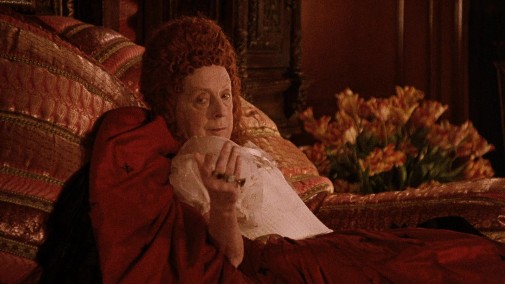
Attention to the oneiric term, for it's a necessary reminder that Sandy Powell's creations for Orlando don't follow strict historical accuracy. The Elizabethan costume is a delight of contradiction, keeping faithful to factual details almost no other designer cares about – actual period shoes instead of the hegemonic boot – while taking stabs at anachronism like the polyester tights Powell got from Wolford. It's a stylized purview of the past that rings true, even in its deviations, fakery that tastes like real beyond real. Even the accurate designs ring with deconstructed unreality, as when we see Elizabeth undress, glimpsing the undergarment engineering that shapes a human body into the icon, the Virgin Queen.
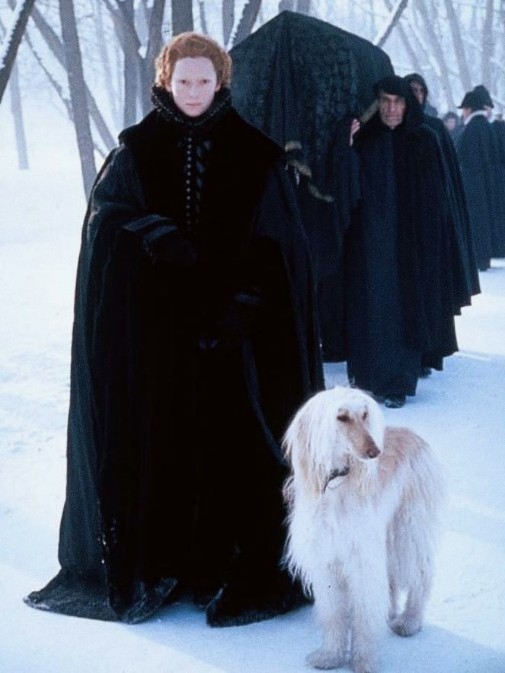
"Do not fade. Do not wither. Do not grow old," says she, and Orlando obeys. As the years advance, the autumn of 1600 grows colder, a winter for 1610 when we find the prodigal son burying his father. The procession slashes a shadow over a snowy landscape, mourning black standing out on the icy terrain. Orlando, in particular, is a glorious vision. Mourning becomes him, all different textures of cross-hatch-patterned velvet, a doublet with great depth despite the tone on tone, and pearl adornments like stars in the night sky. Orlando's dark colors bleed into the world around him, everyone keeping faithful to death rites even though they're unconnected to his loss.
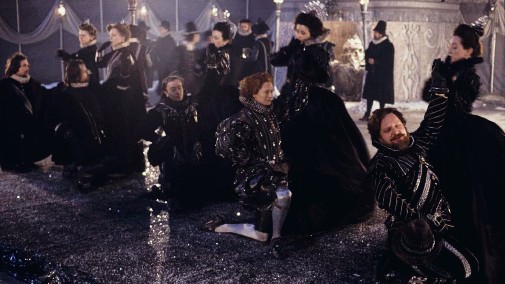
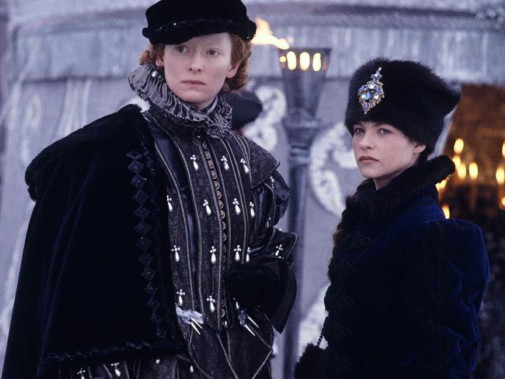
Love is the idea at the center of the episode, the orphaned Orlando falling for a visiting Russian while enjoying King James' follies on the frozen Thames. These amorous inclinations make the gloomy fashions even more curious. But of course, Powell thrives in curious incongruities, enlivening the murk with sparkle, the glint of gold aglets swaying like fruit from branch-like arms. Again, using anachronistic materials and theatrical exaggeration helps evoke history without embalming it, stripes of silver lamé as trim on pumpkin breeches, stiffened stomachers, and the whole Cossack convoy. How pretty it all is, how excessive – how different from England under Puritan rule.

That's where our story takes us next, after Orlando's lover leaves him heartbroken, soul returned to poetic purpose. In 1650, the writer noble obeys new cultural directives, sober black-and-white with an emphasis on supposed severity. Oh, but there's a breath of romance, innocence, to the poet's dress. Notice that oversized butterfly bow tying a lace jabot in absurd proportion. To modern eyes, it, his ribboning shoulders and petticoat breeches may appear feminine. Still, they follow the male precedent of yore. Everything changes. Also, he's a fop, superficial to the bone, his innocence perchance better called naivete.
So forth, the man's poetry doesn't survive scrutiny. His aspirations are soon destroyed by a lower-class man whose appearance is much less polished but whose speech is far more honest than the red-headed beauty's. That rebuff still seems to haunt Orlando in 1700, when he petitions the king and queen for a change of airs, visiting a royal court where everything is ghostly pale. It may be a retread of Greenaway's 1982 The Draughtman's Contract, an homage. Whatever the case, Powell finds opportunity in the milieu to make a winking gesture towards the incoming gender bend. She has Orlando wear slight panniers to jut out his coat's ample skirt, fabric moving with a flamboyant swish.
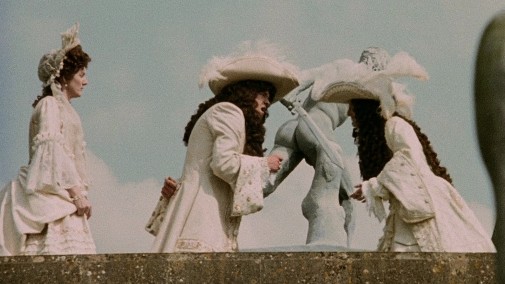


We see little of this 1700s Orlando in England, though. He's off to Constantinople, where the climate demands different fashions. True, he starts in the king's ivory but soon bleeds into gold-trimmed ambassadorial red, losing layers along the way, before friendship with the Khan incurs an adoption of Turkish styles. Between new friends and the representatives of his old home, Orlando code-switches, trapped in a warring world where his male role is uncertain – the ideal time for a change of pace, mayhap more. Like caterpillar turns into butterfly, so does Orlando's sleeps as if in a chrysalis. Waking from slumber, nobleman has become woman.
"The same person, not different at all, just a different sex" – so may be, but society has different demands for women than men. Arriving in 1750, Orlando has settled uneasily into her old new life, something immediately highlighted by how Potter and Powell detail the construction of the preferred Rococo silhouette. Only the designer has taken some details to proportional extremes, widening paniers to dimensions usually seen in portraiture and court wear, but never the everyday clothes of an aristocrat walking around her estate. Part of the design's purpose is to trap Orlando in a symbolic prison, hinder movement.
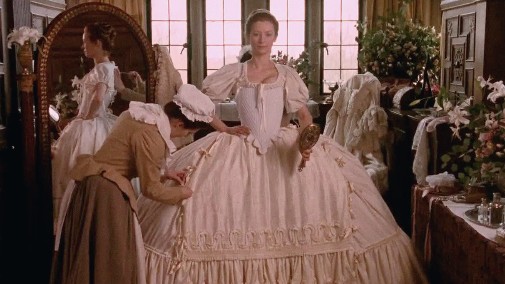

When undergarments are covered in ivory silk with cording detail, the robe à la française floats like a ghost's shroud. Burning bright in the darkness of wood-paneled corridors, she strikes a pallid phantom, almost rhyming with the sheet-veiled furniture. It's as if, trapped by expectations of femininity, she's been made into an object within her own home. Once, she was red flame on green gardens, black velvet on snow – a man of contrast. Now, background and character are becoming a material unity. That's even more evident when entertaining company, people, and décor merge in a flowery mess of pastels.
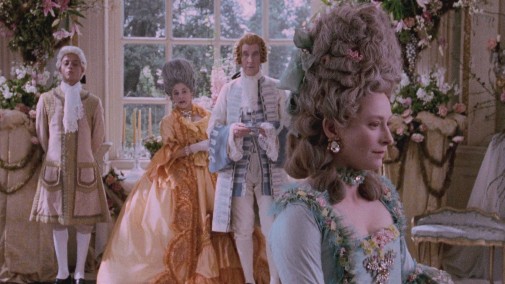
You can almost smell perfumed silk flowers trying to smother malodorous sweat, a suffocating sensory suggestion. Paired with nasty comments on her intelligence, not to mention the advances of an unwanted suitor, it's understandable that Orlando runs. Paniers turn to crinolines in this magic cut, volumes echoing over 100 years difference. Pistachio dupioni, the hue of sweet Ladurée macarons, sours into a misty bleakness, darker and more saturated for a new post-Industrial Revolution world where aniline dyes had taken the world by storm. It was this labyrinthine transition when heroin escapes into her garden maze in Rococo finery and comes out in Victorian garb, that would inspire Andrew Bolton, the MET's curator.

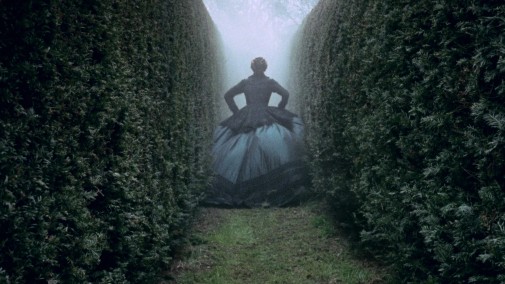
In 1850, Orlando discovers sex in the company of an American, Billy Zane' Shelmerdine, plaid silks, and garnet jewelry put aside when two naked bodies come to know each other. Their passion ages, hoop skirts giving way to bustles as Orlando's feminine sex puts her in crisis with Queen Victoria's state. Woolf wrote Orlando for her lover, Vita Sackville-West, who, like the novel's titular character, saw herself unable to inherit her family's property because of laws privileging male over female lineage. It's something of a love letter, making it logical that Orlando starts to resemble her real-life reference more and more as the film goes on.
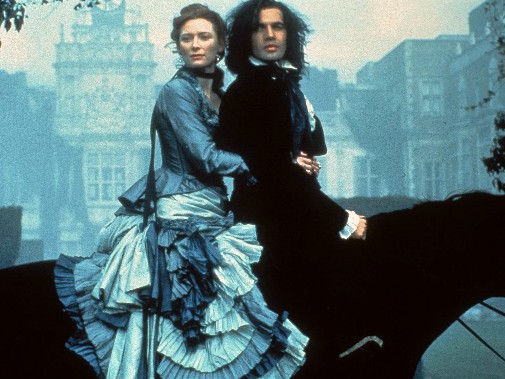
Here, androgyny is in the repeated ruffles and long ribbon, the woman's long-trained skirt and the man's billowing shirts. Buffeted by wind and rain, they look a reflection of each other, butterfly wings flapping on a world of purples and browns. Their separation separates the last of the film from its episodic structure. Along with Orlando, we're jettisoned into the 20th century. Though behind-the-scenes stills exist, showing a very Woolf-Sackville-West-esque Orlando in the 1920s, it's in the 1990s that the film shall end. This reminds the viewer of the distinctions between how the author saw her novel and the director still sees her film.
Gender dominates the literary work, but Potter's exploration implies Orlando's journey as one where anti-conformity is found in fluidity. And so, the protagonist is one whose ideals become anathema to society's conscriptions. Reaching a point of crisis in masculine perception, Orlando transforms. Later, she finds obstacles, again and again, she transforms for compliance is not an option. From Elizabeth I to Elizabeth II, Orlando comes to the filmmaker's present, styled toward androgyny, the binary of gender, another renegaded rule. In this state, the ghost of Sackville-West reaffirms itself, as if Orlando had finally become the queer figure they were written to honor, make immortal. Orlando would have also earned Sandy Powell her first Oscar in my dream world, but that's a matter of little importance when a masterpiece.
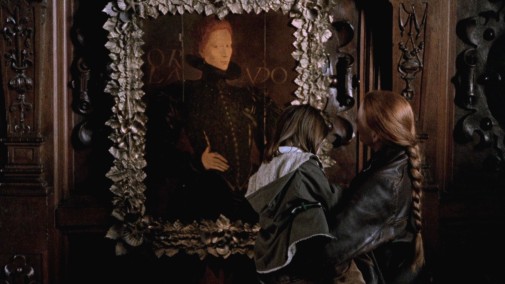
Orlando is currently streaming on MUBI. You can rent it from Amazon, Apple TV, Google Play, Youtube, and VUDU.



Reader Comments (6)
It's been years since I saw this film as I saw it in my teens as I was more interested in seeing Swinton naked than the premise of the film as I was baffled by it.
This whole series is excellent. I'll try to comment later. Overwhelmed by so many inspired choices.
Breaking boundaries with bold costumes, Orlando queers the Oscars in a fascinating and transformative way.
Flat Roofing Services in Ohio
Your posts are very detailed and meticulous, hope that next time you will have more good articles to share with readers. If you have more time, please visit: scribble io
I love watching movies in which the main characters have their own individual style. it inspires me a lot for my own outfits.
Same thing! It's especially cool to see it on TV shows. I often take a sneak peek at what's available this season on popular shows, then I go to my favorite online store meadowweb and buy these popular items at great prices. Literally, just now I saw that the oversized t-shirt by Nanamica is available on this site . It is really trending and you should hurry if you want to buy it at a good price.